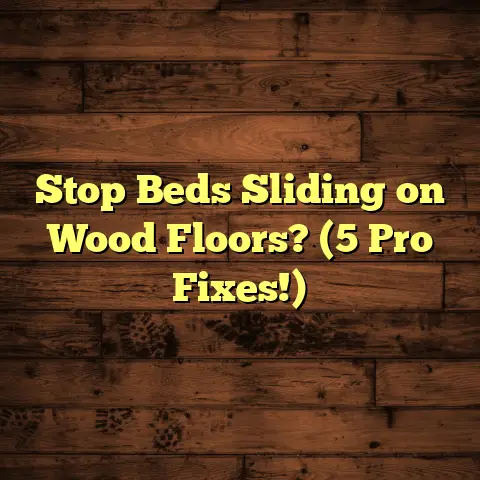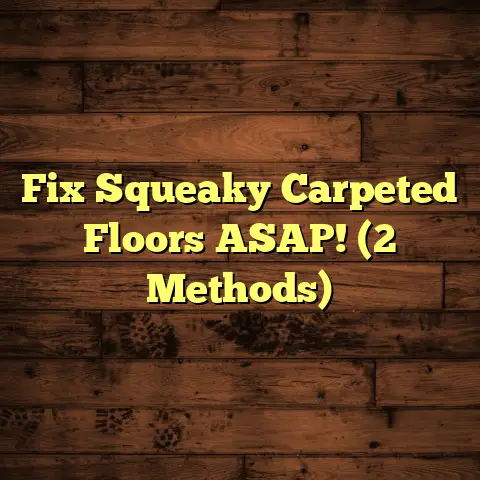Flooring Box Dimensions? (7 You Missed!)
Ever bought too much flooring? I know I have, and it’s a pain! It’s like, you’re staring at those extra boxes, feeling the sting of wasted money and the hassle of returns.
That’s why understanding flooring box dimensions is so critical. It’s the key to getting your project right the first time, saving you both time and money. Let’s dive into everything you need to know about flooring box dimensions!
Understanding Flooring Box Dimensions
So, what exactly are flooring box dimensions?
Simply put, they’re the measurements of the box your flooring comes in. This includes length, width, height, and weight. But more importantly, it also tells you how much actual flooring is inside that box.
Think of it like this: you’re not just buying a box; you’re buying the square footage of beautiful flooring hidden within.
Now, flooring comes in all shapes and sizes.
Hardwood, laminate, vinyl, tile – each has its own typical box dimensions. Let’s take a peek at how they differ.
-
Hardwood: Often comes in longer planks, meaning longer boxes.
-
Laminate: Similar to hardwood, but sometimes slightly shorter lengths.
-
Vinyl: Can be planks or tiles, impacting box size.
-
Tile: Usually square or rectangular boxes, depending on the tile size.
The Importance of Accurate Measurements
Alright, why sweat the small stuff?
Why are accurate measurements so crucial?
Because a simple miscalculation can lead to a domino effect of problems. Trust me, I’ve seen it happen!
I once had a client who eyeballed their room measurements. They ended up short about 20 square feet of flooring! Cue the frantic calls to the supplier, potential delays, and a very unhappy client.
Accurate measurements are the foundation of a successful flooring project. They ensure you:
-
Buy the right amount of flooring: No more, no less.
-
Avoid project delays: No running back to the store mid-installation.
-
Stay within budget: No unexpected costs for extra materials.
Common Box Dimensions for Different Flooring Types
Alright, let’s get down to brass tacks.
What are some typical box dimensions you might encounter?
Keep in mind these are just general guidelines. Always check the specific product information for the most accurate dimensions.
| Flooring Type | Typical Box Dimensions (inches) | Coverage per Box (sq ft) |
|---|---|---|
| Hardwood | 80 x 6 x 4 | 20-25 |
| Laminate | 50 x 8 x 3 | 15-20 |
| Vinyl Plank | 48 x 7 x 2 | 25-35 |
| Tile | 12 x 12 x 4 (for 12×12 tiles) | Varies, usually listed per tile |
As you can see, there’s a range even within the same flooring type. A wider plank of hardwood will mean less planks per box for the same coverage area.
This chart is a great starting point, but always double- check the manufacturer’s specs!
The Impact of Box Dimensions on Installation
Okay, so you know the box dimensions. How does this impact the actual installation process?
Well, larger boxes can be heavier and more difficult to maneuver, especially in tight spaces. Smaller boxes might mean more trips to grab materials, slowing you down.
Here are some tips to handle varying box dimensions:
-
Plan your layout: Think about where you’ll stage the boxes to minimize trips.
-
Account for waste: Factor in extra material for cuts and mistakes (usually 5-10%).
-
Mix boxes: When installing, pull planks from multiple boxes to ensure color variation is evenly distributed.
Seven Box Dimensions You Might Have Missed
Now, let’s get to the really good stuff.
These are the seven often-overlooked dimensions that can make or break your project.
1. Width and Length Variations in Planks
You might think all planks of the same type are created equal. Not so!
Even within the same brand, there can be slight variations in width and length. These differences, while small, can add up over a large area, leading to uneven gaps or alignment issues.
Pitfall: Ignoring these variations can lead to a frustrating installation with visible imperfections.
Solution: Before installing, measure a few planks from different boxes to get a sense of the range. Adjust your layout accordingly.
2. Thickness Variations in Flooring Options
Thickness matters, especially when transitioning between different flooring types. A slight difference in thickness can create a tripping hazard or an unsightly transition.
Pitfall: Installing flooring of different thicknesses without proper transition strips can look unprofessional and be unsafe.
Solution: Use transition strips to smoothly bridge the gap between different floor heights. Consider self- leveling compounds to even out subfloors before installation.
3. Weight Considerations and How It Affects Shipping and Handling
Don’t underestimate the weight of those boxes!
A single box of tile can weigh upwards of 50 pounds.
This affects shipping costs, your ability to move the boxes, and even the structural integrity of your floor.
Pitfall: Overlooking weight can lead to back injuries or exceeding the weight capacity of your floor joists.
Solution: Check the weight of each box before ordering. Use a dolly or hand truck to move heavy boxes. Consult a structural engineer if you’re concerned about floor load.
4. Box Dimensions for Underlayment and Padding
Don’t forget about underlayment!
It’s a crucial component of many flooring installations, providing cushioning, sound insulation, and moisture protection. Underlayment comes in rolls or sheets, and its dimensions need to be factored into your overall project planning.
Pitfall: Forgetting to account for underlayment can lead to purchasing the wrong amount or choosing the wrong type for your flooring.
Solution: Calculate the area you need to cover with underlayment and choose a product with the appropriate dimensions. Consider the thickness and density of the underlayment for optimal performance.
5. Custom Sizes for Specialty Flooring
Sometimes, you want something unique.
Specialty flooring, like reclaimed wood or custom-cut tile, often comes in non-standard sizes. This can impact box dimensions and require more precise calculations.
Pitfall: Assuming standard box dimensions for specialty flooring can lead to significant shortages or overages.
Solution: Work closely with your supplier to understand the exact dimensions and coverage of your specialty flooring. Be prepared for longer lead times and potentially higher costs.
6. Box Configurations (Number of Pieces per Box)
This one seems obvious, but it’s easy to overlook.
The number of planks or tiles per box directly impacts the total coverage area. A box with fewer pieces will cover less square footage.
Pitfall: Not paying attention to the number of pieces per box can result in miscalculating the total amount of flooring needed.
Solution: Always check the product label for the number of pieces per box and the total square footage coverage. Double-check your calculations to ensure you’re ordering the correct amount.
7. Regional Differences in Box Dimensions Based on Manufacturer Standards
Believe it or not, box dimensions can vary slightly depending on the manufacturer and even the region where the flooring is produced.
Pitfall: Assuming consistent box dimensions across different brands or regions can lead to unexpected shortages or overages.
Solution: Always verify the box dimensions with the specific supplier you’re working with. Be aware that imported flooring may have different standards than domestic products.
Calculating Coverage Based on Box Dimensions
Okay, let’s put all this knowledge into action!
Here’s a step-by-step guide to calculating coverage:
-
Measure your room: Accurately measure the length and width of your room in feet.
-
Calculate the area: Multiply length by width to get the total square footage.
-
Determine coverage per box: Check the product label for the square footage coverage per box.
-
Calculate the number of boxes needed: Divide the total square footage by the coverage per box.
-
Add extra for waste: Multiply the number of boxes by 5-10% to account for cuts and mistakes.
Example:
Let’s say you have a room that’s 12 feet long and 10 feet wide. You’re installing vinyl plank flooring that covers 30 square feet per box.
- Area: 12 ft x 10 ft = 120 sq ft
- Coverage per box: 30 sq ft
- Boxes needed: 120 sq ft / 30 sq ft/box = 4 boxes
- Waste (5%): 4 boxes x 0.05 = 0.2 boxes (round up to 1 box)
Total: You’ll need 5 boxes of vinyl plank flooring.
Flooring Trends Influencing Box Dimensions
The world of flooring is constantly evolving, and design trends are influencing box dimensions.
One major trend is the rise of wide plank flooring.
Wider planks create a more spacious and luxurious look, but they also impact box dimensions. Fewer planks fit in a box, and the boxes themselves can be larger and heavier.
Impact: Wide plank flooring can be more expensive due to the increased material and shipping costs.
Considerations: If you’re considering wide plank flooring, be sure to factor in the larger box dimensions and potential cost increases.
Conclusion
Alright, we’ve covered a lot of ground!
Hopefully, you now have a much better understanding of flooring box dimensions and why they matter.
Remember, being informed is the key to a successful flooring project. By paying attention to these often- overlooked dimensions, you can avoid costly mistakes, reduce waste, and ensure a perfect fit.
So, next time you’re planning a flooring project, take the time to understand the box dimensions. It’ll save you time, money, and a whole lot of frustration!
FAQs Section
How do I measure my room for flooring?
Use a measuring tape to measure the length and width of the room in feet. If the room is not perfectly square or rectangular, break it down into smaller sections and measure each one separately. Add the areas of each section together to get the total square footage.
What if I have leftover boxes after installation?
Most retailers will accept returns of unopened boxes of flooring. Check the store’s return policy before purchasing. You can also try selling leftover flooring online or donating it to a local charity.
How much extra flooring should I buy for waste?
A general rule of thumb is to add 5-10% extra for waste. For complex layouts or intricate patterns, you may want to add even more.
What is the best way to store flooring boxes before installation?
Store flooring boxes in a dry, climate-controlled environment. Avoid storing them in direct sunlight or in damp areas. Stack the boxes flat to prevent warping.
Can I mix different lots of flooring?
It’s generally not recommended to mix different lots of flooring, as there can be slight color variations. If you must mix lots, try to distribute the planks or tiles evenly throughout the room to minimize any noticeable differences.





